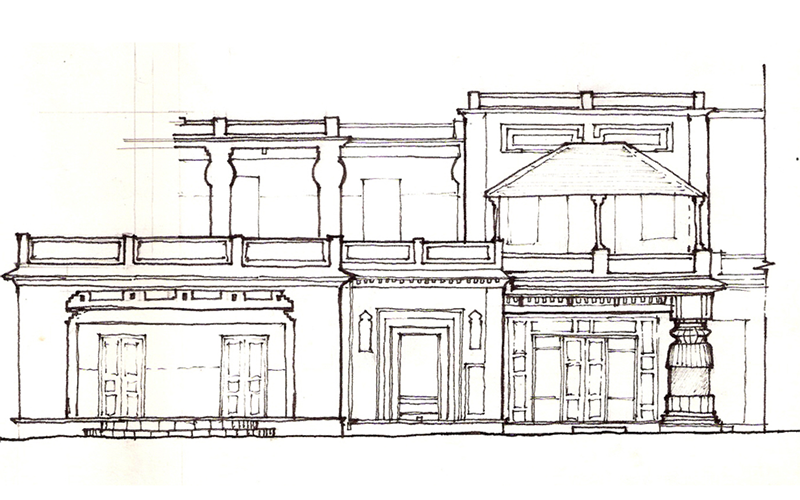 Research
Research

Subject
Shaping the Modern: Architectural Cultures as Critique in Late Colonial India (c.1913-48)
First and second supervisors
Abstract
Saptarshi’s research examines key departures from mainstream colonial-modern architecture in British India, focusing on built environments’ roles in critiques of the Imperial State. He supplants the question: ‘how do social conditions shape architectural practices?’, with: ‘how can built environment practices or forms act as modes of social change?’ The inquiry problematises extant historical narratives that hastily designate, ostensibly unrelated sites as aberrations in influential surveys on architectural modernity.
Examining agency and structures of thought and production at these sites, Saptarshi’s study suggests that they collectively constitute experimental critiques of a dominant, rationalising, homogenising social and technocratic (colonial) order through their built propositions across histories of social, cultural, scientific and economic fields of ‘modernity’. These ‘architectural cultures’ – encompassing modes of practice, layers within a site, questioning a preoccupation with the figure of the bona fide architect through aspects like finance and labour – are read through a ‘connected histories’ method; a method grounded in socio-cultural and postcolonial theories of space in intellectual, discursive and material terms.
The study, firstly, aims to unpack and articulate a geography of these architectural cultures in late-colonial India. It examines cross-cultural, interpersonal and affect-based exchanges of thought and ideas among particular colonial subjects, and their interconnections among figures both within South Asia as well as further east and the west, as networks of knowledge. Thinking through these networks qualifies the multi-authorship and collaboration(s) integral to the texture of architectural modernity in India at this time. Furthermore, it critically examines innovations wrought in material attributes of key built environments herein and their socio-spatial performance. Concurrently, it interrogates how such practices were the means to experiment with and explore modern cultural constructions in colonised India through education, development-paradigms, artistic expressions and scientific knowledge.
The outcome(s) of Saptarshi’s research, therefore, seeks to look beyond polarised values of imperial-modernity and reactionary resistance. It contributes to a broader discourse on plurality and hybridity in architectural modernity, by (re)positioning how certain built environment practices, in this particular historical moment and geopolitical region, operate as the “means to” think through, shape and perform the modern on colonised peoples’ own terms.
Biography
Saptarshi Sanyal holds an both a BArch and an MArch in Architectural Conservation and has been an Assistant Professor at the School of Planning and Architecture (SPA), New Delhi, since 2013. He currently teaches History and Theory in Year 3 of Architecture BSc at The Bartlett.
Primarily a full-time educator and researcher in architecture, its histories and visual storytelling, Saptarshi has also contributed through part-time tutorials and workshops in various institutes all over India. Following independent and private consultancy (2008 – 10), he has worked with the Archaeological Survey of India as a Conservation Architect (2010 – 13). He is also an independent photographer with ongoing personal projects and numerous publications. His photographic work has been exhibited both nationally (in India) and internationally.
Saptarshi is a Commonwealth Scholar, funded by the UK government (2018-21), to carry out his PhD at The Bartlett, UCL. He has been generously supported with academic leave for this period by his home institution in India.
- Publications
- (Chapter) ‘The evolving role of India’s foremost heritage custodian: Archaeological Survey of India’ In Preservation Practice in India: Current Trends (tentative title) (New York: Oxford University Press, forthcoming, 2020).
- (Chapter) ‘The Imperial Record Office in Delhi: An Architectural Paradox’ (with first author: Nalini M. Thakur) In Structural Analysis of Historical Constructions: an interdisciplinary approach (Cham: Springer, 2019, pp 205-215).
- (Journal article) ‘Amateurs and authors: challenges and potentialities in architectural historiography of late-colonial India’ SPACE - Journal of the School of Planning and Architecture, New Delhi (2018, 22:1-4).
- (Journal article) ‘Cultural Plurality and Innovation in Design of Temples in Bengal – Tradition and Continuity’ SPACE - Journal of the School of Planning and Architecture, New Delhi. (2016, 20:1-2, 23-40).
- (Journal Article) ‘The Poet’s Home: Architectural innovations in Rabindranath Tagore’s dwellings in Santiniketan’ International Journal of Arts and Sciences. (2015, 8: 8, 593-611).
- (Opinion-Editorial) ‘Disrespecting Heritage’ the Indian Express. (27 January 2015, 15).
- (Chapter) ‘Brick Bonds’ In PIX Quarterly, Surge, the Pakistan Issue (New Delhi: Goethe Institut, 2014, pp 92-99).
- (Chapter) ‘The subjective truths in objective realities of Tagore’s dwellings in Santiniketan’ In Towards Tagore (Kolkata: Visva Bharati, 2014, pp 408-442).
- (Article) Sanyal S. ‘Process and knowledge in some aspects of vernacular architecture in Kerala’ Explore Rural India: magazine of the Indian Trust for Rural Heritage Development (2014, 2:1; 57-60).
- (Journal Article) ‘Paradigms for structural conservation: Observations and approaches for the Sun Temple, Konarak’ Context: Built, Living and Natural - Journal of the Development and Research Organisation for Nature, Arts and Heritage (2013, 19:2, 109-118).
- (Chapter) ‘Monitoring heritage through efficiency process algorithm: identifying relevant indicators’ In Bhopal 2011: Landscapes of memory (New Delhi: NTNU / Space Matters, 2012. pp 162-166).
- (Conference) ‘Exclusion and efficiency in Measuring Heritage Conservation Performance’ CECI-ICCROM. Proceedings of the 6th International Seminar on Urban Conservation: measuring heritage conservation performance. Recife, Brazil. (Rome: ICCROM, 2011, 212-221).
- (Web Article) Sanyal, S. Calcutta Contradictions. Invisible Photographer Asia (2011)
http://invisiblephotographer.asia/2011/07/25/photoessay-calcuttacontradictions-saptarshisanyal/ - (Book) ‘The Sun Temple, Konark: past, present and future’ (with first author D.V. Sharma) (Bhubaneswar: Archaeological Survey of India, 2010).
- (Chapter) ‘Contemporary Relevance of Traditional Principles in Architecture and Urbanism’ In New Architecture and Urbanism: Development on Indian Traditions (Newcastle: Cambridge Scholars, 2010, pp 314-317).
- (Journal article) ‘Discovering the incognito’ Indian Architect and Builder (2009, 22: 9; 44-47).
- (Conference) ‘Significance of a Mughal Mall and its role in Achieving Safety: the Knowledge System that is Chatta Chowk Bazar’ Proceedings of SAHC 08: Safety and Significance - 6th International Conference on Structural Analysis of Historic Constructions, Bath. United Kingdom. (London: Taylor and Francis, 2008, 161-167).
Image: Patha Bhavana (school building) at Santiniketan: part elevation sketch by Saptarshi Sanyal.
 Close
Close

